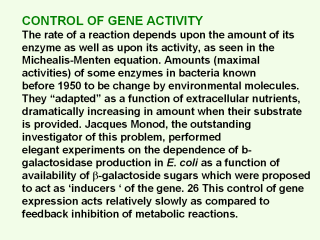 |
As an early
molecular-genetic mechanism by which gene expression
is activated to produce enzymes, Roger Stanier early made the
hypothesis that bacterial catabolism successively produces
inducing molecules that cause as set of enzyme to
appear. A breakthrough was made in 1959, the PaJaMa
experiment, so named for the authors 27 and because it
depends on bacterial mating. In brief, mutants of
inducible E. coli were made that constitutively produce β-galactoside,
independent of an added inducer. The key experiment
consisted of mixing these genes by mating wild-type
β-galactosidase inducible bacteria with a constitutive
mutant that also has an inactive β-galactosidase
gene. Then which gene
dominates—whether the recipient mated cells are
inducible or constitutive was determined. The enzyme
activity, in absence of inducer, increased within minutes after mating.
And it stopped after two hours unless inducer was
added. Also, the reciprocal transfer of the
constitutive gene into inducible cells did not cause
constitutive enzyme production. Furthermore, Monica
Riley, et al. in 1962 demonstrated that synthesis of
β-galactosidase
by the mated cells requires integrity of the
introduced DNA, because destruction of the introduced
gene by radioactive decay of 32 P incorporated into it
caused cessation of enzyme synthesis.28 |
